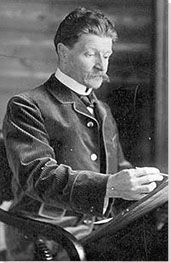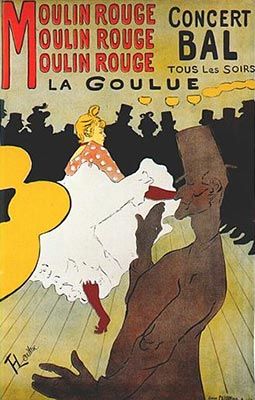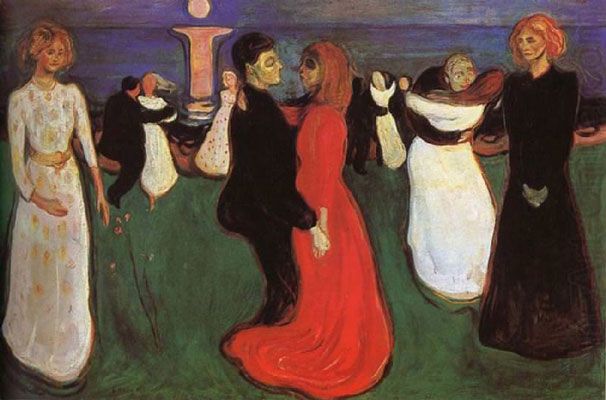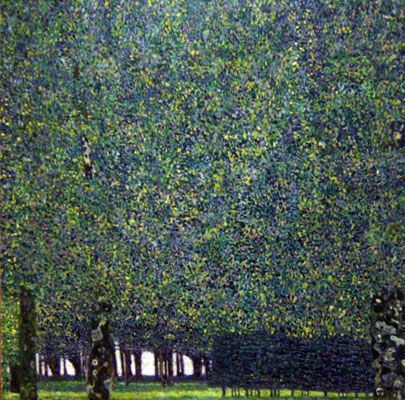Summary of Mikhail Vrubel
Vrubel's ground-breaking works challenged orthodoxies within Russian art, so much so that they were often misunderstood by his peers. Though under-appreciated in his own lifetime, he has now been 'reclaimed' by history as one of the founding fathers of the Russian avant-garde.
Vrubel made his early reputation on a series of oil paintings and earthenware sculptures based on Russian folklore and to which he brought elements of Symbolist painting and Art Nouveau. Later, he created graphic illustrations to accompany the poetry of Mikhail Lermontov and from whom he took inspiration for his famous "Demon" works. The figure of the Demon became a motif in Vrubel's oeuvre and was read thus as the personification of the artist's very own inner turmoil. Indeed, the artist spent the last years of his life in mental institutions though it was during those years that he painted some of his most unusual works, some of which are now cited as seminal examples of Russian Art Nouveau.
Accomplishments
- Breaking with all the traditions and techniques of the Academy of Arts in St. Petersburg, Vrubel's painting conveyed a profoundly spiritual and lucid inner life that accommodated darkness and mental confusion. It is this mystical element to Vrubel's art that takes the spectator far beyond the frame of his paintings.
- Put off by the Russian church's rejection of his art, Vrubel abandoned Catholicism and Russian Orthodoxy and turned his attention towards philosophy. He was drawn especially to Immanuel Kant believing that the route to true spiritual enlightenment was linked to the idea that one could only achieve full self-realization through personal creativity.
- Once residing in Moscow, Vrubel was exposed to new artistic styles emerging from western Europe. The decorative and natural style of Art Nouveau, and specifically its focus on aesthetics, sat well with his Kantian worldview. Enthused by the possibilities for the new style, and willing to experiment with Symbolism and Middle Eastern decorations and designs, Vrubel became a pioneer in what would be a colorful, and specifically Russian, Art Nouveau. One finds several similarities between Vrubel and the Symbolist mosaics of Gustav Klimt.
- Vrubel was revered for his dense brush strokes and his penchant for breaking his figures into an almost anarchic mass of facets and planes. This has led several enthusiastic commentators to cite Vrubel as an early forerunner of Cubism. In paintings such as Venice (1893) Vrubel had started to self-consciously experiment with collage and cube-shaped forms. Indeed, when Venice was first exhibited in Paris, Pablo Picasso was so taken with the work he called Vrubel a "genius".
The Life of Mikhail Vrubel
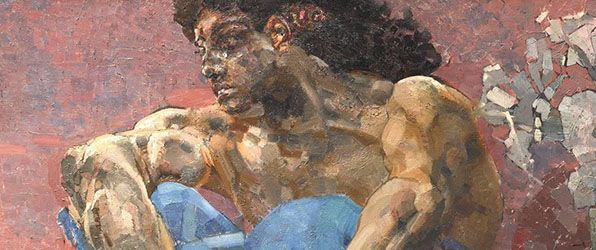
Mikhail Vrubel lived a troubled life; dogged with depression and put into an institution after his only son’s death, he also spent his last years in a psychiatric clinic. It is little wonder then that the motif he is best known for is the demon which he depicted in paintings throughout his life.
Important Art by Mikhail Vrubel
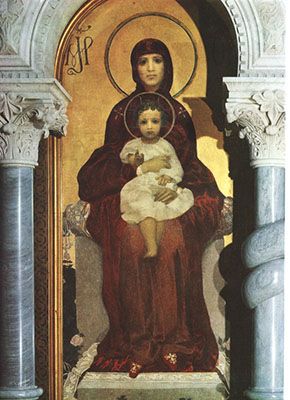
The Virgin and Child
Hung between highly decorative columns and an arch, The Virgin and Child is one of several murals Vrubel helped restore in the Church of Saint Cyril in Kyiv during the early 1880s. Though they were restorations rather than original works (Vrublev worked as part of a team of students restoring over 150 works over a period of seven months) the murals still carried the artist's signature style.
The formal composition of The Virgin and the Child is taken from conventional depictions of the Virgin and Christ and demonstrates the Vrubel's full engagement with Russian, Byzantine, and medieval Christian pictorial traditions. The folds of the fabric, the pensive facial expressions, and the use of rich colors and gold are akin to that which Vrubel would have seen in Russian orthodox churches growing up, and also on his travels to Venice undertaken in the same year that this piece was painted.
In his 1911 biography of Vrubel, the artist Stepan Iaremich described the works produced in Kyiv during the 1880s as the best of Vrubel's career. Whilst this opinion may not hold up to scrutiny, Iaremich's comments do account for the importance of the Kyiv paintings in developing a style seen throughout Vrubel's later work. The murals at the Church of Saint Cyril can be seen in fact as the beginnings of Vrubel's exploration of spirituality and personal faith, ahead of his rejection of religion and experiments with Symbolism. Here, in the solemnity and thoughtfulness of the figures' gazes, the viewer can begin to see Vrubel contemplating fulfillment and peace as attained through insight and personal reflection.
Oil on board - Church of Saint Cyril, Kyiv, Ukraine
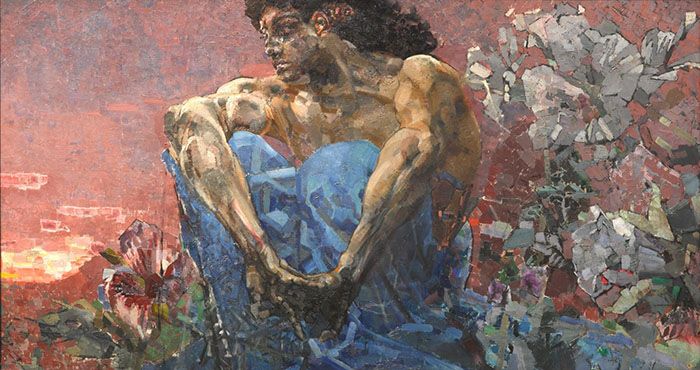
Demon Seated
Whilst still working in Kyiv on the restoration project, Vrubel began to experiment with illustrations of "The Demon" which he based on the description of a Demon in a poem by Mikhail Lermontov, the most important poet and writer of the period and, to this day, the greatest hero of Russian Romanticism. The influence of the Saint Cyril restoration is clear in Vrubel's use of thick brushstrokes to create a mosaic-like texture. This is particularly apparent to the right of the Demon figure, where the geometric shapes created by the brushwork break the plane down into an abstract space. As the art historian Maria Taroutina notes, here the viewer can see Vrubel employing "medieval means to modernist ends". Vrubel's treatment of the figure of the Demon is finely detailed while he emphasizes the mood of solitude by placing his subject against a blank and infinite, background. The monumentality of this work was described by Vrubel's patron Mamontov as the "fascinating symphonies of a genius".
Vrubel himself described the Demon as "a spirit which unites in itself the male and female appearances, a spirit which is not so much evil as suffering and wounded [...] a powerful and noble being". The ambiguity of the Demon's gender is mirrored in the uncertainty of the setting. The landscape is distant and creates feelings of solitude and uneasiness: the Demon could be looking off into the distant sunset, or it could be the fires of hell. This painting demonstrates Vrubel's own personal rejection of Christianity and the fixed stability of religion at this time in his life in favor of a view that creative accomplishment would bring him spiritual content. The Demon is pensive and expressive, weighing up in his mind personal faith, torment, and resignation, much like Vrubel himself did in these years before he was admitted to psychiatric care.
Isolated and reflective, Vrubel rejects the traditional religious view of the Demon as an evil being, blurring the boundaries between good and evil - Christ and Satan - to give a more modern view on the spiritual individual. In this rejection of traditional dichotomy, the artist urges the viewer to consider instead the individual soul: the sense that introspection is the path, not mass religion.
Oil on canvas - State Tretyakov Gallery, Moscow
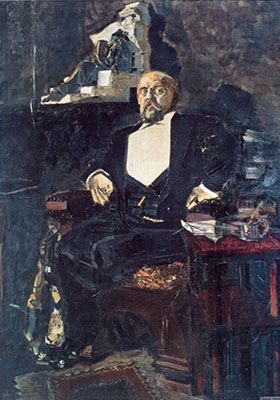
Portrait of Savva Mamontov
In this portrait, the viewer can see the influence of folk art and the church mosaics and murals Vrubel helped to restore in his early career. The artist uses thick brushstrokes to create a mosaic-effect in the background of the painting, using subdued colors to make the bolder figure of Mamontov stand out in the foreground. Surrounded by the objects associated with a wealthy art collector, such as luxurious fabrics and furniture, Mamontov is also dressed the part in his pristine suit. It demonstrates what art historian James Curtis describes as the "strong theatrical quality" of Vrubel's art.
Vrubel is less well-known as a portrait painter (perhaps as it is not abstract enough a medium to convey Symbolist ideas) but he did produce many during his lifetime. What is significant to note, however, is that his portrait work mainly consists of depictions of people he knew well, such as the poet Valery Bryusov and his own wife Nadezhda Zabela, who Vrubel painted repeatedly. Therefore it seems only natural that Vrubel would paint such a portrait of his patron and friend Savva Mamontov during his residency at Mamontov's artist community: the Abramtsevo Estate. The pair were close, with Vrubel accompanying the Mamontov family on a holiday to Italy in 1891. A descendent of a wealthy merchant family, Mamontov encouraged and celebrated artists working across disciplines with interests in traditional Russian folklore and crafts. The art historian Hanna Chuchvaha describes Abramtsevo as a place which "represented a revival of vernacular art and the stylization of folk art".
Oil on canvas - State Tretyakov Gallery, Moscow
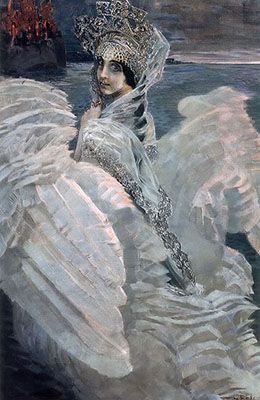
The Swan Princess
The majority of this painting is taken up by an almost abstract rendering of the Swan Princess's white feathers. Vrubel uses light brushstrokes to create the texture of feathers, from which the more detailed figure of the Swan Princess emerges, with an intricately painted jewelled headpiece and veil. The dramatic nature of the foreground figure and the mysterious backdrop is distinctive of turn-of-the-century artworks inpired by Russian folklore and fairy tales, whilst the wide-eyed and pensive gaze of the Swan Princess is reminiscent of Vrubel's depictions of the Virgin in his contributions to the Saint Cyril restoration in Kyiv.
The drama and theatricality of this painting carries the influence of Vrubel's marriage to the opera singer Nadezhda Zabela, which took place four years prior to this work being produced. Following the marriage, Vrubel moved into the world of theater, designing stage sets and costumes for several ballets and operas. Here, the wide-eyed protagonist is modelled on his wife when she starred in the role of the Swan Princess in Rimsky-Korsakov's The Tale of Tsar Saltan. It is this very personal element which causes this painting to be, in the words of the art historian Lydia Iovleva, "seething with passion and powerful temperament".
Oil on canvas - State Tretyakov Gallery, Moscow
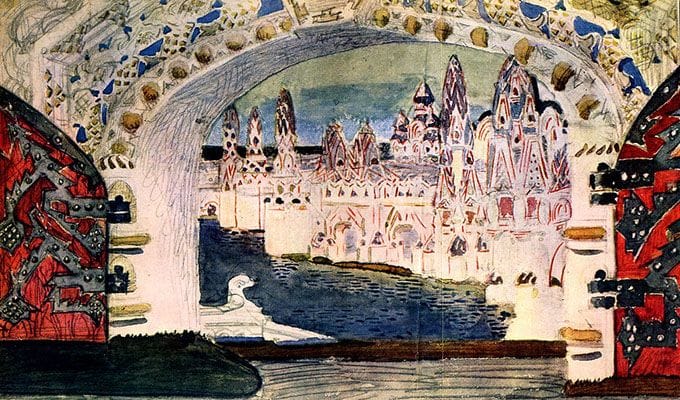
The City of Ledenets, from The Tale of Tsar Saltan
Between 1896 and 1901, Vrubel painted set designs and produced costumes for 9 operatic productions as part of Savva Mamontov's Moscow Private Opera Company. The archway and gates are heavily ornate and exotic, featuring dark colors and a liberal use of gold. The patterns both here and in the domed city that lies beyond are based on Vrubel's exploration with texture, such as ceramics, stained glass and mosaics.
The opera was based on a fairytale by the classic Russian poet and playwright Aleksandr Pushkin. In the tale, the mystical city of Ledenets arises from the sea overnight, an effect Vrubel achieved through the use of the colors blue and white. The story features ideas of duality between reality and dream, which Vrubel again illustrates in his set design sketch through fantastically intricate and luxurious patterns and manipulation of space to create a three-dimensional atmosphere. He had dealt with the decoration of large-scale areas before, such as church frescoes, but here he uses the space to create dynamism and a sense of depth. Beyond the heavy doors and archway, the kingdom of Ledenets unfolds through a cluttered array of domes and towers, drawing the viewer in. The artist's wife, who starred in the production, said that Vrubel "really distinguished himself in the Saltan decorations, and even his terrible enemies the newspaper critics, say that the decorations are beautiful".
Watercolor and pencil on paper - Bakhrushin Museum, Moscow
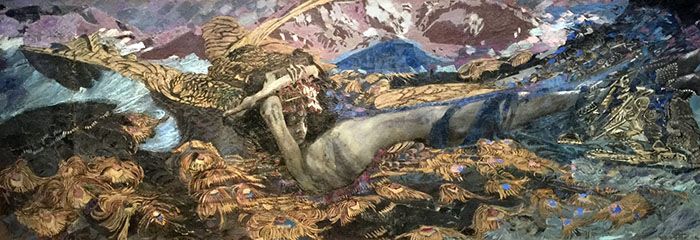
The Demon Downcast
While its image, an evolving lietmotif throughout his ouvre, was based initially on Lermontov's poem, Vrubel's fascination with the figure of the Demon is thought to have begun after seeing Anton Rubenstein's opera The Demon in Kyiv sometime around the mid-1880s. The development of Vrubel's Demon can be illustrated through two of his most iconic works; works that act ostensibly as bookends to his career: Demon Seated (1890) and, twelve years later, Demon Downcast.
Like Demon Seated, Vrubel employs mosaic-like textures to create an abstract and unidentifiable backdrop against which the Demon figure lies. This is, however, where the similarities end. In this piece, the Demon figure is dramatically changed: it has lost the muscular stance of the previous Demon, and instead lies prostate (rather than seated) and amaciated. It has also lost the pensive gaze of the previous Demon, and instead stares directly and challengingly at the viewer. Vrubel used a metallic bronze powder in elements of this work in order to reflect the light, similar to Russian icons and art found in Russian orthodox churches.
The Demon returns to haunt Vrubel (or vice versa) in this painting. The headpiece worn by the Demon has been interpreted as a crown of thorns, which again creates an ambiguity between Good and Evil and reflects the artist's own rejection of religion. The crown of thorns alludes to sorrow and sacrifice, reflective of Vrubel's own state of mind at this time; indeed, following the exhibition of this work, he suffered a severe nervous breakdown. The Symbolist landscape painter Konstantin Bogaevsky recalled viewing the painting upon its showing at the World of Art exhibition in 1902: "It produced a strong impression on me, which I can compare to no other. It glowed as if it were made of precious gems, so that everything around it seemed gray and unsubstantial" he said.
The World of Art group had organized a total of six exhibitions between 1898 and 1904 in St. Petersburg and Moscow though the last exhibition was a failed attempt by Dyagilev to prevent the group's Moscow members from "defecting" to The Union of Russian Artists group (that was formed in 1903).
Oil on canvas - State Tretyakov Gallery, Moscow
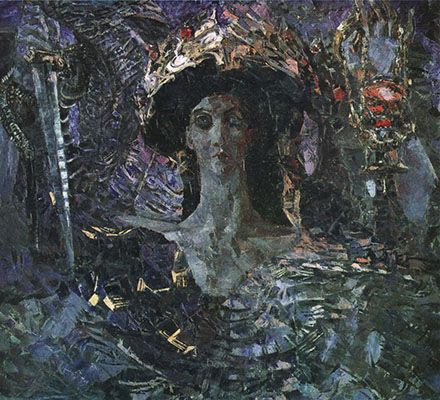
The Six-Winged Seraph
This painting is intimately linked Vrubel's earlier Demon paintings, both in its style and subject matter. Taking to biblical form again, the artist renders the figure monumentally dominating the canvas, against a mosaic-like background of interlocking paintstrokes. Elements of gold and metallics create a sense that the painting is shining, whilst the seriousness of the face, the hollowed eyes, and the ambiguous gender of the seraph echoes Vrubel's Demon figures of previous years. Hands ominously appear from the mist of the backdrop: one holds a glowing red orb whilst the other hovers a dagger above the head of the viewer.
Painted six years before Vrubel's premature death, The Six-Winged Seraph was one of the largest works of the artist's late career. This painting shows the culmination of a lifelong fixation and battle with religion, and an increasing need to explore the themes of redemption, suffering, and repentance. As noted by the art historian Maria Taroutina, Vrubel's later paintings have often been dismissed as some of his weaker work, but can also be interpreted as a sign of his increasingly deteriorating mental health. Yet, as before, Vrubel's early influences of the Renaissance and Byzantine are used to modernist ends to create radical forms and convey spiritual themes.
One can find clear similarities between Vrubel and the Symbolist paintings of Gustav Klimt, leader of the anti-establishment Viennese Sucession. Like Vrubel, Klimt's mature works made use of symbolism to convey psychological ideas - typically related to sexual liberation and human suffering - and to promote the thesis that art should be freed from the laws of traditional culture. And, like Vrubel, Klimt's paintings and murals used shimmering patterned mosaics and rectangular and concretic patterns to create lavishly decorated figures and backgrounds.
Oil on canvas - State Russian Museum, St Petersburg
Biography of Mikhail Vrubel
Childhood
Mikhail Vrubel was born in 1856 in the city of Omsk in southwestern Siberia. One of four children, his mother came from old Russian nobility, and died when Vrubel was just three years old. His father, Aleksandr Mikhailovich Vrubel, was of Polish descent and a military man, and raised his children to be familiar with both Roman Catholicism and the Russian Orthodox church.
On completing school, Vrubel decided to follow his father's example and enter a military career. He served in the Imperial Russian Army and the Astrakhan Cossacks, experiencing conflict firsthand through his participation in the Caucasian and Crimean Wars. After the wars, Vrubel studied to become a military lawyer, graduating from the Faculty of Law at St. Petersburg University in 1880.
Throughout his military endeavors, Vrubel's father recognized and encouraged his son's artistic talents, even funding his education in painting through private tutors. Whilst studying at St Petersburg, Vrubel took evening classes at the city's Academy of Fine Arts, eventually becoming a full-time post-graduate student where he studied under Pavel Christyakov. He was also able to access the Academy's museum and archives, which contained specialist collections of Early Russian art, including medieval Byzantine works and Russian icons.
Early Training and Work

Before completing his studies, Vrubel's work came to the attention of the art critic and historian Professor Adrian Prakhov, who came to the school to recruit students to help restore the twelfth-century murals and mosaics in the Church of Saint Cyril in Kyiv. Vrubel's contribution to the restoration proved crucial both to the project, and to his own career, since it provided him with an education in Byzantine color and methods which would infuse his own works.
Vrubel remained in Kyiv for five years though he visited Venice in 1884 to study the Italo-Byzantine church mosaics as research. He was particularly taken with the mosaics in the Basilica of San Marco and the works of artists Bellini and Carpaccio.
Following the restoration of the Church of Saint Cyril, Vrubel struggled to find paid work. Returning to Russia, he settled in Odesa, and in 1886 entered a competition to design for the newly built Cathedral of Saint Vladimir. However, his unconventional ideas were vetoed. This rejection, and the financial hardship Vrubel faced during the late 1880s, prompted him to rethink his religious and philosophical worldview. He stepped away from organized religion and began to question his Christian faith, becoming an avid reader of the works of philosophers such as Immanuel Kant. Increasingly, Vrubel was drawn to the idea that he would achieve spiritual fulfillment only through the pursuit of his creative endeavors.
Mature Period
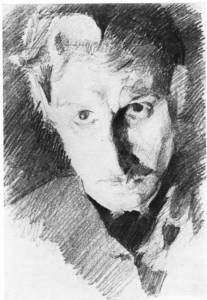
In 1890, Vrubel relocated to Moscow. Here he found other artists who were experimenting beyond the boundaries of painting into applied arts such as pottery and ceramics, stained glass, and costume and set design. New ideas and artistic trends from Europe could be seen in Moscow, and it was here that Vrubel became acquainted with the nascent Art Nouveau style. In direct contrast with the historic styles taught in the nineteenth century, Art Nouveau sought inspiration from the patterns and movements found in nature, often through the use of modern materials and decorative arts rather than painting. Encouraged by the idea that art is not separate from its surroundings, Vrubel excelled in experimenting, developing a keen interest in Oriental arts such as Persian carpets, and the development of texture in painting.
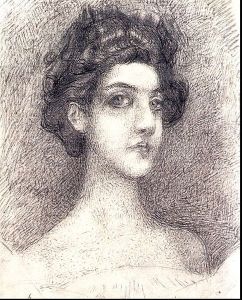
The decision to move away from painting and fine arts and move more towards the applied arts was certainly influenced by his marriage to the famous opera singer Nadezhda Ivanovna Zabela in 1896. Vrubel designed stage sets and costumes for his wife, who sang in productions of Rimsky-Korsakov's operas, including The Snow Maiden and the parts of Princess Volkhova in Sadko and the Swan Princess in The Tale of Tsar Saltan.
In 1898, the artists Alexandre Benois and Léon Bakst, together with the art critic Sergei Diaghilev, founded the art journal-cum-manifesto World of Art (Mir Iskusstva) which promoted the Russian version of Art Nouveau. The trio organized several exhibitions alongside the journal and it was through the exhibition tour, which travelled throughout Europe, that Vrubel's reputation grew internationally (not least through the endorsement of Pablo Picasso). Vrubel's work and that of his World of Art contemporaries, including Konstantin Somov and Eugene Lansere, offered a different take on western European features in the way it infused Art Nouveau with a specifically Russian aesthetic: namely bright colors, folkloric tales, and traditional patterns.
Late Period
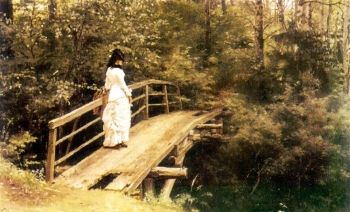
Through his wife, Vrubel became acquainted with Savva Mamontov, an industrialist and keen patron of the arts. Since the 1870s, Mamontov had owned the Abramtsevo Estate near Khotkovo, north of Moscow, and run it as an artistic colony (the "Abramtsevo Colony"). One of the key aims of the community were to explore Russian folk art and the quality of medieval production in order to produce beautiful pieces of furniture, ceramics, and textiles. The group of artists, writers and designers who gathered there to share and exchange ideas - including Vrubel, Isaak Levitan, Ilya Repin, Yelena Polenova and Apollinary and Viktor Vasnetsov - became known collectively as the Mamontov Circle. Vrubel became a major figure in the Circle, designing murals and stage sets: Mamontov even appointed him the head of the ceramic workshops. Alongside artists Konstantin Korovin and Valentin Serov, Vrubel became deeply involved with life in the colony: together they took part in amateur dramatic and musical productions. Vrubel wrote in 1891 that at Abramtsevo he managed to find "that intimate national note that [he] so wanted to capture on canvas and in ornament".
Within this move towards experimentation in different art forms, the signs of a particular style began to emerge: Symbolism. In Russia, Symbolism was first realized in literature at the end of the nineteenth century, such as in the work of the poet Aleksandr Blok and the novelist Andrei Bely. Vrubel was, according to the art historian Lydia Iovleva, "the first conscious, principled Symbolist among painters". The Symbolist principle of expressing psychological truth and the artist's inner mind through art provided a key outlet for Vrubel, who struggled with his mental health throughout his life. Whilst other artists were using the Art Nouveau style as a vehicle to paint in the realist manner, Vrubel gradually moved into Symbolism as a means to explore spiritual thoughts, sometimes even through abstract forms that were a long way removed from the social realm of everyday life. Soon other artists from the World of Art group also began to experiment with Symbolism including Victor Borisov-Musatov and Mikhail Nesterov.
After the turn of the twentieth century, Vrubel's mental health deteriorated and following a severe nervous breakdown, he was hospitalized. He continued to paint whilst at a clinic but was compelled to stop as he became increasingly blind in the last years of his life.
The Legacy of Mikhail Vrubel
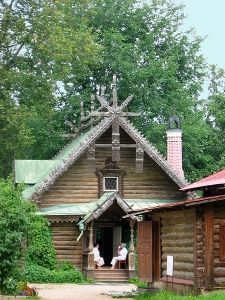
Vrubel was one of the first artists in Russia to explore the Art Nouveau style and how the concepts of Symbolism could be explored in visual art. By looking back at the artistic methods of the past, he used such techniques to create a style that was concerned with the spiritual rather than the religious. These ideas, although dismissed by competition juries when pitching work at the time, were more readily appreciated by a new generation of Russian artists.
The need to look backwards in order to move forwards, and the suggestion that art should not be limited to canvas alone, were ideas that continued to resonate well into the twentieth-century in Russia and further afield. As the art historian Roberta Reeder has commented, "it was he more than any other Russian artist of this period who was to have a decisive influence on the direction art would take in the next generation of Russian artists".
Vrubel's stage-work was revered by artists of the World of Art group in St Petersburg, including the founder of the Ballets Russes, Sergei Diaghilev. Parallels of influence can be seen in major artists of the decade following Vrubel's death: Pavel Filonov, Wassily Kandinsky, and Kazimir Malevich for example. Professor Adrian Prakhov's son, the painter Nikolai Prakhov, wrote of the beginnings of Rayonism in Vrubel's paintings, and likened them to the folk-based art of Mikhail Larionov and Natalia Goncharova. The sculptor Naum Gabo stated meanwhile that Vrubel "freed the arts of paintings and sculpture from the academic and realist schemata. His genius is responsible for moulding the visual consciousness of our generation which came after him".
Influences and Connections

-
![Giovanni Bellini]() Giovanni Bellini
Giovanni Bellini - Pavel Christyakov
- Vittore Carpaccio
- Savva Mamontov
- Adrian Prakhov
-
![Renaissance]() Renaissance
Renaissance -
![Byzantine Art]() Byzantine Art
Byzantine Art -
![Art Nouveau]() Art Nouveau
Art Nouveau - Medieval Russian painting
-
![Wassily Kandinsky]() Wassily Kandinsky
Wassily Kandinsky -
![Mikhail Larionov]() Mikhail Larionov
Mikhail Larionov -
![Ilya Repin]() Ilya Repin
Ilya Repin ![Leon Bakst]() Leon Bakst
Leon Bakst- Konstantin Somov
-
![Sergei Diaghilev]() Sergei Diaghilev
Sergei Diaghilev - Konstantin Stanislavsky
- Konstantin Korovin
- Valentin Serov
-
![Symbolism]() Symbolism
Symbolism -
![Art Nouveau]() Art Nouveau
Art Nouveau -
![Rayonism]() Rayonism
Rayonism - Russian Moderne
- Russian Primitivism
Useful Resources on Mikhail Vrubel
- Modernism and the Spiritual in Russian Art: New PerspectivesOur PickEdited by Louise Hardiman and Nicola Kozicharow
- The Art of Mikhail Vrubel (1856-1910)Our PickBy Aline Isdebsky-Pritchard
- The Russian Experiment in Art: 1863-1922By Camilla Gray
- From Russia: French and Russian Master Paintings 1870-1925, From Moscow and St PetersburgBy Albert Kostenevich, Anna Poznanskaya, Alexei Petukhov, Lydia Iovleva, Yevgenia Petrova, Vladimir Lenyashin, Hubertus Gassner, and Christina Lodder
- New Perspectives on Russian and Soviet Artistic Culture: Selected Papers from the Fourth World Congress for Soviet and East European StudiesBy John O. Norman (ed.)
- Art Periodical Culture in Late Imperial Russia (1898-1917): Print Modernism in TransitionBy Hanna Chuchvaha
